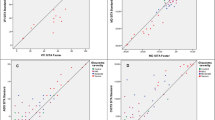Abstract
The analytical programme Delta was used to determine longterm fluctation and accuracy of measurement of the programme 31 of Octopus when used on glaucoma patients. Programme 31 examines the 30° field. The test locations are arranged in a square grid with 6° resolution. The programme Delta determines and compares 1) the disturbed area in %; 2) the total loss, the total sensitivity being around 2000 dB; 3) the loss in dB per mean number of disturbed points. Thirty-two eyes of 22 patients with established glaucomatous field defects were examined twice within two to six days and two months later again twice. The size of the disturbed area served for classification of our sample into three groups: 1st group: disturbed area 1–33%; 2nd group: disturbed area 34–66%; 3rd group: disturbed area 67–100%.
Long-term fluctuations and accuracy of measurement could be determined as respectively follows: 1) Disturbed area between 0.7 ± 8% in group 3 and 1.7 ± 13% in group 2. 2) The total loss increases proportionately to the disturbed area and was 4.9 ± 29.2 dB in group 1 and 31.8 ± 82.4 dB in group 3. 3) The total loss per mean number of disturbed points was 0.5 ± 2 dB in group 1 and 0.3 ± 1.2 dB in group 2. This signifies that if the learning effect is over, changes of more than 2 dB, especially if several adjacent points are affected, are a significant loss. The learning effect, as determined in an earlier study, may go up as high as 2 dB per point.
Similar content being viewed by others
References
Bebie, H. & F. Fankhauser. Ein statistisches Programm zur Beurteilung von Gesichtsfeldern. Klin. Mbl. Augenheilk. 177: 417–422 (1980).
Gloor, B., U. Schmied & A. Fässler. Glaukomgesichtsfelder - Analyse von Octopus-Verlaufsbeobachtungen mit einem statistischen Programm. Klin. Mbl. Augenheilk. 177: 423–436 (1980a).
Gloor, B., U. Schmied & A. Fässler. Difference between true changes and long-term fluctuations in glaucomatous visual fields as revealed by the automatic perimeter Octopus. In Greve, E.L., ed.: 4th International Visual Field Symposium, Bristol. Docum. Ophthal. Prod. Series Vol. 26. Dr. W. Junk Publ. The Hague, In press.
Häberlin, H., A. Jenni & F. Fankhauser. Researches on adaptive high resolution programming for automatic perimeter. Int. Ophthal. 2: 1–9 (1980).
Heijl, A. & S.M. Drance. Automatic perimetry in glaucoma. A clinical study with three computerized perimeters. In Greve, E.L., ed.: 4th International Visual Field Symposium, Bristol. Docum. Ophthal. Prod. Series Vol. 26. Dr. W. Junk Publ. The Hague. In press.
Krieglstein, G.K., W. Schrems, E. Gramer & W. Leydhecker. Detectability of early glaucomatous field defects: a com- parison of Goldmann and Octopus perimetry: In Greve, E.L., ed.: 4th International Visual Field Symposium, Bristol. Docum. Ophthal. Prod. Series Vol. 26. Dr. W. Junk Publ. The Hague. In press.
Li, S.G., G.L. Spaeth, H.A. Scimeca & N.J. Schatz. Clinical experiences with the use of an automated perimeter (Octopus) in the diagnosis and management of patients with glaucoma and neurologic deseases. Ophthalmology 86, 7, 1302–1312 (1979).
Schmied, U. Automatic (Octopus) and manual (Goldmann) perimetry in glaucoma. Albrecht v. Graefes Arch. Klin. Ophthalmol. 213: 239–244 (1980).
Author information
Authors and Affiliations
Rights and permissions
About this article
Cite this article
Gloor, B., Schmied, U. & Fässler, A. Changes of glaucomatous field defects. Int Ophthalmol 3, 5–10 (1980). https://doi.org/10.1007/BF00136207
Issue Date:
DOI: https://doi.org/10.1007/BF00136207




